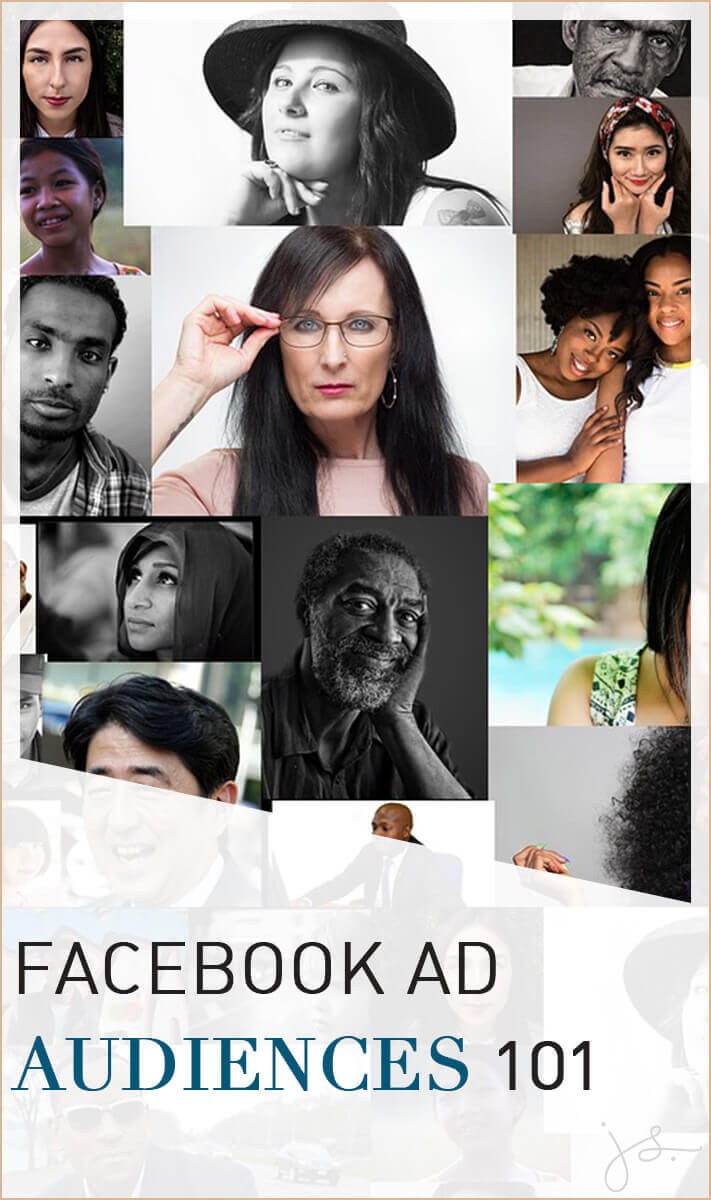If you’re new to Facebook Ads or just haven’t seemed to have luck yet…this video is for you! I go into the three different types of audiences, when and how to use each. I also explain how the audiences work together and the flow to use in your business.
This training is perfect for people who are running all kinds of ads – to products both digital and physical.
This video will go through the difference between:
- Custom Audiences
- Saved Audiences
- Lookalike Audiences
…and when and why you’d use each of these types.
Video Transcript:
Hey Julie here, today I want to talk about Facebook Ad Audiences 101. So this is for beginners. People who are still not sure about Facebook ads and I want to explain the different types of audiences that you can use when you’re targeting your ads.
So the first type we’re going to talk about are the saved audiences.
Saved audiences basically are people that you come up with who are cold. They’re cold, they don’t know who you are. They don’t really know what the solution is to their problem. They just are a cold audience of people who have a problem.
Okay so let me explain what a saved cold audience is. Let’s say you’re doing a course on gardening and you want to find people who are gonna like your course. So you want to think what do gardeners like?
A perfect example would be, “hey they like Better Homes & Garden- the magazine.” So that would be an example. So a saved audience would require you to go to Facebook and find the people who like Better Homes and Garden.
So Facebook allows you to target people based on Facebook pages they already like. So with saved audiences, you want to look for Facebook pages that people like that are like yours.
So, in my industry, I often talk about ads and funnels. So I target Russell Brunson because he’s a big name and facebook has him as an interest.
I also target people who like Marie Forleo.
I target people who like Amy Porterfield.
So I’m looking for Facebook pages that people like that are like yours. So if you’re a gardener, you’re doing Better Homes and Garden. You’re doing big gardening figures in that industry that have facebook pages that you can target.
So Saved Audiences can also be based on demographics.
So if you’re a local business and you’re creating a saved audience, maybe you want to target people in certain zip codes.
Or you can even target people based on upcoming birthdays.
So if you’re a restaurant you can say “hey it’s your birthday come in for a free drink,” you can do any upcoming birthdays of course.
You can do gender, you can do age, you can do country, and you can also do things like how much money they make. So like income level. This is helpful in some industries.
All right so this is all part of the Saved Audiences.
A couple tips and tricks.
There are also certain behaviors that are really helpful depending on the industry.
In my industry, I’m often looking for business owners so I do things like Facebook page admins.
And I use that.
Sometimes I come up with a big audience and then I ask “hey I want to target only people who have Facebook pages because I know business owners have Facebook pages.” So these are saved.
In general, you want to look for audiences except for the local people where the audiences are gonna be small. You want to look for audiences anywhere between like 100k and… I don’t know 900k-ish. That’s a good starting range. There are exceptions to every rule, but these are cold audiences that don’t know you yet.
Okay, all right.
Number two are Custom Audiences.
Okay, now Custom Audiences are built with people who already know you.
So a good example here is your email list. You can actually take your email list out of your email service provider, you can export it and you can upload it to Facebook. And then you can send ads directly to people who are on your list.
This is a really good idea when you’re doing a launch and you have a big product that you’re selling. So they’re getting the emails from you and they’re seeing the ads. So that’s an example of a custom audience.
Another is video views. So views, hold on I can’t spell, video views.
These are people who’ve engaged with your Facebook lives in your videos. If you’ve run any video view ads to cold traffic, now you can create a custom audience of those people who have already watched your videos.
You can also create a custom audience of people who’ve engaged with your page whether they’ve liked, comment, commented or shared.
Finally, custom audiences based on website traffic.
Okay so this is a big one and this is where you start to use the pixel.
So if you put your pixel on your funnels, you put it on your website, when people land in your funnels and on your website you can create all kinds of custom audiences based on what pages they landed on all over the Internet.
So this is exactly how Amazon… like when you go to Amazon and you look at you know a cool little piece of jewelry and then you go back to Facebook now you’re seeing ads for jewelry.
They’re basically targeting you because you landed on that page and now they’ve created a custom audience and they’re showing you a new ad.
So this is custom audiences.
This is for warm traffic and these can be much smaller audiences… so you know sometimes it can only be fifty a hundred people when you’re doing retargeting all right.
And the third type of audience is a look-alike audience.
And a look-alike audience is a cold audience. Okay, it’s still a cold audience.
This is the warm audience section and this is cold.
Now well look-alike audience is really simple. It is a big audience. So once you’ve set up a campaign with the cold traffic and it starts to get some traffic and you see that it’s working, what’s gonna happen is you’re gonna blow out your audience and you’re gonna run out of people and people are gonna start to see your ad multiple times and then they’re gonna get annoyed and then they’re gonna report the ad and then your ads gonna do poorly and it’s gonna
be sick- very sad.
So eventually once you get a campaign going really well, you need to get a bigger audience.
This is where look-alikes come in. So as that audience is growing, usually people are taking action they’re becoming part of your list. They’re making purchases.
You can create look-alike audiences based on all the actions these people are taking.
So these people usually become part of your email list.
Maybe they actually visit your website.
Maybe they make a purchase and so you create look-alike audiences based on website traffic, based on engagement, based on your email list. And what you do is it creates an audience of people who look like the people who did all these things.
Now, these audiences tend to be 1 million and higher so it can be like anywhere from like 1 to 2 million. You can even get it as big as like 2 to 6 million.
And this is great because now you’re telling Facebook “all right now I’ve got a big budget I’ve got a big audience find people who look just like these people and show them my ad. “
And those are the three main audiences that you’re going to use in ads.
The last thing I want to say is if you are testing ads and you’re testing different audiences make sure that the audiences don’t overlap too much.
When you go into the ads manager, you can actually check the box next to two audiences and under the “actions” you can choose “show audience overlap” and it will show you how much they overlap.
And you don’t want this to be too big because otherwise, you’re competing against yourself in the auction.
So you want to make sure there’s not too much overlap and if there is, just combined them into one audience.
Hope that helps see you soon.









0 Comments